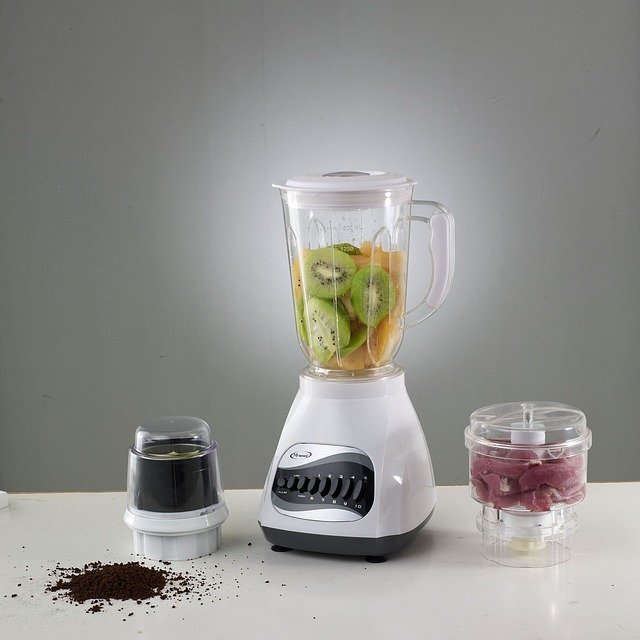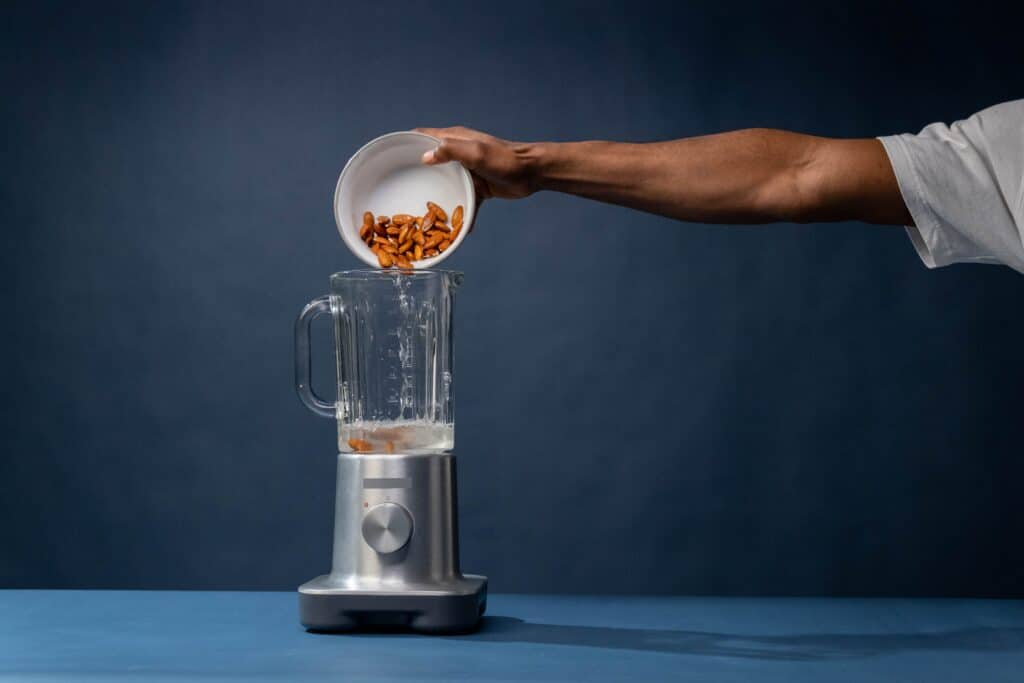When you purchase through links on our site, we may earn an affiliate commission. Here’s how it works.
Food Processor vs Blender
Food processor vs blender is a hot issue among kitchen equipment enthusiasts. This is because they both operate on the same concept.
The ingredients container rests on the blades, and the processor blends the food.
If you spend some time getting to know them, you’ll notice that they have distinct characteristics (except you use a blender-food processor combo).
However, you’ll be surprised to learn that they weren’t founded and developed for the same reasons.
Today, you will learn the differences between food processors and blenders.
Moreover, you’ll learn more about their functions and affiliations and how they’re occasionally used to doing the same tasks.

Food Processor vs Blender – Find the Differences
What is a Food Processor?
A food processor is a multi-functional electric appliance that is used to prepare a wide variety of foods.
Chopping, shredding, and creating dough are just a few of the tasks that a food processor can swiftly do.
The food processor has four essential parts: A base, a transparent plastic body, a pair of replaceable blades, and a lid. The speed and pulse control is positioned on the base of food processors.
A food processor’s vast and expansive body allows it to prepare more significant recipes. The tall feed chutes on food processor lids will enable you to add ingredients while they’re being mixed.
Unlike blenders, which usually only come with one blade attachment, food processors can have various attachments for shredding, slicing, grating, chopping, mixing, and other operations.
They may also include bowl inserts that allow you to accomplish many chores with different compartments simultaneously.
What is a Food Processor Used for?
A food processor is a multi-purpose kitchen appliance that may be used for various tasks.
A food processor is an excellent addition to any kitchen, especially if you want to prepare a large amount of food at once.
To make nut butter, for example, combine the nuts with a small amount of oil.
When you use a food processor to prepare your meals, the possibilities are unlimited –
- Preparing the dough
- Vegetable chopping and slicing
- Meats and nuts grind
- Cheese grating
- Baby food should be pureed
How to Use Food Processor?
If you’re considering buying a food processor and want to learn how to operate it, these simple instructions will help.
Furthermore, following these procedures will allow you to utilize your food processor’s capabilities fully.
Step 1: Plug Food Processor
The first step in this procedure is to connect the food processor to a power source.
Step 2: Connect the Jug and the Base
Set the jar on the base before moving on to the next step. Now, spin the bowl anti-clockwise to secure it in place.
Step 3: Select a blade or an attachment.
The next step is selecting the blade or attachment that best suits the work. Attach the knife blade to the jar’s center mechanism if you want to mince, chop, mash, or puree something.
Step 4: Place the Lid in Its Proper Placement
Once you’ve found the proper blade or attachment, it’s time to close the food processor bowl with the lid.
Step 5: Add Ingredients
You can add the ingredients now to process them if you’re using a shredding or slicing disc.
Add ingredients by pushing them via the funnel or the lid’s feeding tube until they directly contact the disc.
Step 6: Turn it on and watch the magic
Once you have put the entire ingredient in the container, it is time to turn on the appliances. After 10-15 minutes, depending on the time, you will see the ingredients turning into a puree.
Step 7: Turn off the processor and clean the elements
After you’ve finished, please turn off the appliances and clean them thoroughly before storing them. It will not only keep the processor working, but it will also extend its lifespan.
What is Blender?
A blender is an electric appliance designed to combine solid and liquid components.
Like food processors, blenders contain four parts: a motorized base, a pitcher, a set of (often removable) blades, and a cover. The base controls can include speed and mix settings.
Most blender pitchers are conical in shape, having handles and pouring spouts.
The revolving blades of a blender screw into the bottom of the pitcher, making them easy to remove for cleaning.
What is a Blender Used for?
Smoothies, soups, sauces, and gravies can all be made with a blender.
A blender can do the job if you’re searching for a quick and easy way to make a smoothie.
This appliance mixes, emulsifies, and purees food. Blenders are also known as liquidizers because they produce a large amount of liquid.
While any blender can handle soft and freeze-dried items, a robust model is needed to powder ice, frozen fruits, and other hard materials.
If you’ve ever looked for a food processor, you’ve come across a long list of its capabilities, including chopping, slicing, shredding, combining, and pureeing.
Even though blenders are getting more sophisticated, they can’t do all a food processor can.
How to use Blender?
For many people, using a blender might be difficult, especially if they’ve never used one before.
When you use it for the first time, it can be less than safe. However, with practice, it will become a natural process you have mastered.
Specific measures must be followed when operating a blender. Before using any equipment, read the instruction manual thoroughly, especially if it is new.
So, continue reading to learn how a blender works.
Step 1: Connect it to a power source
Before connecting the blender to the power source, ensure it’s clean. Wet hands are unsafe when handling electrical appliances, so wipe them dry.
Step 2: Take the lid off the jar and place the contents inside
Make sure you don’t just stuff solid objects inside. This will make it difficult for your blender to move. Put some solid things inside, such as a peeled banana and a small liquid.
This is going to happen quickly. Ensure that the liquid is covering the solid substance at all times.
Don’t put hot foods in the blender; they can break them.
Step 3: Cover the lid, cover it and hold it tightly
When blending, the cap will come off if it isn’t tightened. While blending, you can remove the lid cap to add some more little components.
However, the best option is to keep it closed until you finish blending. The contents may splatter and stain your walls and floor when it opens.
When the blender is turned on, secure the bottom to the base.
Step 4: Turn it on and blend
You’re all set to blend now. Start by testing a few buttons to see if everything is working correctly. Do not attempt high-speed blending at this time.
After you’ve finished trying, select the appropriate speed based on what you’re blending. The high-speed button is located on the far right side of your blender.
The speed increases from the left button to the far right. Please do not use any utensils in the blender until it is fully operational. It may break as a result.
Turn it off before stirring the contents with any utensil.
Step 5: Carefully open the blender and pour out the contents
Your blend is now complete. Pour the solution into a jug that has been set aside. Your content is now ready to be consumed.
You’ve completed the blending task and are ready for the next one.
Step 6: Blender should be clean
After you’ve completed the procedure, you’ll need to clean it thoroughly. Make sure you’re scratching lightly. Wash the blades thoroughly because they tend to retain the blender’s contents.
Washing the blades should be done cautiously because they may result in cuts. Please do not wash them before detaching them from the power source.
Remove the base of your blender and wash the two pieces separately and thoroughly. Do not immerse the base in water.
Wipe any dirt from the towel with a towel. Then, using a towel and soap, wash the top part with warm water.
Before storing the blender, make sure it is scorched. Turn it upside down to drain all of the water.
Step 7: Replace the blades in your blender
Do not leave your blender hanging around until it is clean and dried. You’ll need to store it somewhere safe, clean, and dry. It may break if it hits a hard surface.
Place it somewhere where kids cannot take it and play with it. Allowing your children to blend should only be done under your supervision.

Know the Differences
Food Processor vs. Blender: The Differences
People might confuse a food processor with a blender for various reasons. However, there are also a slew of other reasons not to.
The first is that food processor design is evolving. The Braun 12-cup, for example, is a popular model.
However, traditional units continue to dominate the market. Let’s examine their functions and components to provide a more apparent contrast.
1. Use
The blender is most commonly used to blend smooth liquid combinations, hot or cold, such as smoothies, soups, dips, etc.
Everything about the device, from the blade design to the motor wattage, is designed to achieve that goal.
When a blender is turned on, gravity generates a vortex that pulls the contents down to the base, where they fall on sharp, crushing blades.
The mechanics can’t operate well if the content isn’t good.
On the other hand, a food processor is designed for dry foods and can handle a wide range of ingredients. Standard processors can chop, slice, shred and grate food with their accessories.
The latest models come with more tools and, as a result, more features.
Some food processor types, unlike blenders, can handle liquid substances. Although newer designs have addressed this issue, it’s still a good rule of thumb.
2. Blades for Cutting
The attachments, particularly the cutting blades, are the most significant difference between food processors and blenders.
On the other hand, food processors often feature more than one blade assembly at their base, but blenders typically only have one.
Typically, the processor also contains a slicing disc, a shredding/grating disc, and a chopping blade.
Their functions are rather self-evident. Higher-tier units may include whisking discs, citrus attachments, dough beaters, peeling discs, and other accessories.
The food processor’s most essential tool, the chopping S blade, has little in common with the blender’s blade assembly.
Food Processor vs Blender – Frequently Asked Questions
#1 – Can a blender be used as a food processor?
Answer – Yes, you can. A blender can be used in place of the food processor.
Though you’ll have to adjust a few blender settings, you can make a few recipes you couldn’t make in a blender because a food processor can do more than a blender.
#2 – Can you grind coffee beans in a food processor?
Answer—If you don’t have a coffee bean grinder at home but still want to grind your coffee beans, then yes, you can use a food processor for grinding purposes.
Although you can technically ground them in a food processor, the outcome will be less than ideal.
As a result, you are advised to obtain the appropriate appliances or coffee beans in powdered form.
#3 – Can you make smoothies in a food processor?
Answer—If you are looking for a quick, short answer, yes, you can make smoothies in a food processor, but it’s a bit different.
This is because all components must be put in the correct order rather than all at once, which takes a little longer. However, the food processor will complete the task.
See Also